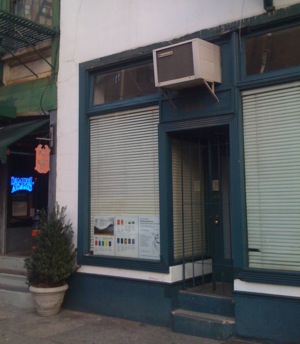Giving It a Whirl
I recently celebrated endured what someone once called a “speed-bump birthday,” and perhaps as a result, I’ve been trying to introduce more novelty into my life, to force myself to jump into new experiences instead of looking for reasons not to. If I often decide that these new experiences—yoga, glassblowing—aren’t for me, well, it doesn’t really matter. The newness was the point.
So when I saw a flyer about a “whirling workshop,” I knew I had to try it. I once watched whirling dervishes at Carnegie Hall and found them entrancing. The idea of whirling seemed childlike in the best possible way, and very liberating. The workshop was to be at Dergah al-Farah, the Nur Ashki Jerrah Community on West Broadway, and while I’m allergic to religion, the community website said, ” We joyfully welcome seekers and students of all religious and non-religious paths into our gatherings.” (Of course, it also said, “The Nur Ashki Jerrahi Sufi Order is a community of dervishes within the Halveti-Jerrahi Tariqat, in the specific lineage and spirit of Shaykh Muzaffer Ashki al-Jerrahi, Shaykh Nur al-Jerrahi, and Shaykha Fariha al-Jerrahi. We are based at Dergah al-Farah in NYC, with various circles throughout the U.S. and Mexico.” Most of which made much sense to me. I know now, from Wikipedia that “Sufism […] is generally understood to be the inner mystical dimension of Islam. A practitioner of this tradition is generally known as a sufi, though some adherents of the tradition reserve this term only for those practitioners who have attained the goals of the Sufi tradition. Another name used for the Sufi seeker is Dervish.”)
I promised myself that I would leave if anyone tried to indoctrinate me, but that was never a problem. Then again, I didn’t make it to the end of the two-hour session.
 Dergah al-Farah is one of those façades you walk by all the time without really noticing much other than that the blinds are always down. (It’s a block north of what used to be the Sufi Books store.) I walked inside, and a man welcomed me and asked me to remove my shoes. He checked my name off a list—I had registered by emailing—took my $20, and offered me dates and tea. I sat next to a few others on the carpeted floor. The room was long and narrow, with side walls of white-painted brick, a pair of crystal chandeliers, some wooden furniture (it looked worship-related, but what do I know?), and large rugs rolled up against one wall.
Dergah al-Farah is one of those façades you walk by all the time without really noticing much other than that the blinds are always down. (It’s a block north of what used to be the Sufi Books store.) I walked inside, and a man welcomed me and asked me to remove my shoes. He checked my name off a list—I had registered by emailing—took my $20, and offered me dates and tea. I sat next to a few others on the carpeted floor. The room was long and narrow, with side walls of white-painted brick, a pair of crystal chandeliers, some wooden furniture (it looked worship-related, but what do I know?), and large rugs rolled up against one wall.
Other would-be whirlers trickled in, and eventually, the instructor, Sakina, joined the ten of us. She has a beautiful face, with warm, friendly eyes. She sat, too, and tried to coax from us the reasons why we were there, what our experiences with whirling were, where we were from. The group was rather international, with attendees from Russia, Chile, Mexico, Spain—and on the younger side (by which I mean younger than I am). I mentioned how the dervishes I saw at Carnegie Hall seemed so free, and how they reminded me of being a child. She liked that, and I felt like a star pupil.
After about 20 minutes, Sakina had us stand in a circle, and we did the kind of breathing exercises (“feel the air move down to your toes”) that tend to come with anything meditative. That’s when I first began to waver, because if you ask me to shut my eyes for more than 30 seconds, I will fall asleep; sure enough I had to fight the urge to yawn, pretty much negating the point of the exercise. Then we walked in our circle, on a four count, right-left, right-left. Sakina introduced new “steps,” building them into a sequence: We were to take four paces, then do a 360-degree clockwise turn over the course of the next four paces, then walk four more paces, and then a counterclockwise turn. The Middle Eastern music was evocative, and focusing on the steps was soothing in the way that anything physically repetitive is when you’re mostly used to exercising your mind. Then Sakina told us to skip on the four-count, and I felt giddy: When was the last time you skipped? I could barely remember how to do it, let alone on a four-count, but it came back, and I beamed. We added skipping and then stomping as new steps at the end of the sequence.
I’ve taken a dance class or two in the past decade, and one of the things that baffles me about getting older is my legs’ refusal to behave as instructed. I knew the steps, but my legs wouldn’t listen, and the walking took far more concentration than it should have. So when Sakina said that she’d be pulling us, in turn, into the center, where we would each introduce a new step—of our own creation—that the rest of the group would have to add onto the sequence, I knew I was in trouble. You don’t ask a drowning man to do a flip turn. I might have persevered had two things not happened. First, the Russian guy’s step involved swinging your arms back and forth—not in of itself a problem, except he re-entered the circle directly in front of me and proceeded to swing his arms back and forth during every step, which totally confused me. Making matters worse, another participant devised a step that led with the left foot, forcing us to ditch our core rhythm every fiftieth pace.
As we marched, I was moving farther from anything transcendent, and I realized I’d never be able to whirl. You have to be able to leave yourself somehow, and I was stuck in a grouchy moment; I was spiraling, but downward. No one, including me, could remember the steps or the rhythm, and trying to follow along was like listening to people clap off the beat. It hurt. Around and around we went, and every time I faced the door, I felt a centrifugal force pushing me toward it.
I like to think of my willingness to leave unsatisfying events as a sign of maturity, although I suppose it could be the opposite. Either way, I didn’t want to ruin the workshop for everyone, so I was mortified when Sakina rushed over to where I was putting on my shoes to see if I was OK. I whispered that I needed to go, that it wasn’t working for me, but thank you so much, etc., etc. She looked heartsick. “But you haven’t whirled,” she said. “You haven’t had that feeling.”
“I’ll have to find it some other way,” I said. And even if I don’t, that’s fine. The point is to never stop looking.
Dergah al-Farah is at 245 West Broadway (Walker/White); 212-966-9773, nurashkijerrahi.org. Whirling workshops will be held monthly.
















